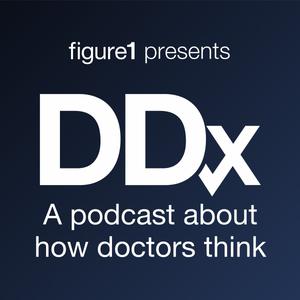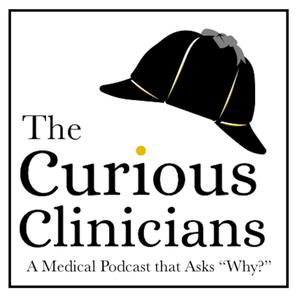
DDx
Figure 1
A podcast about how doctors think. Presented by Figure 1, the knowledge-sharing and collaboration app for physicians and healthcare professionals. Learn more at Figure1.com/ddx
- 10 minutes 44 secondsGiving New Life Through X-linked Hypophosphatemia Research
After a lifetime of treating her rare bone disease, X-linked hypophosphatemia, a patient is at the end of her rope. Due to a genetic variation of the X chromosome — specifically the PHEX gene — there’s an imbalance of phosphate levels in her body. Because of its domino effect on bone development and mineralization, the patient is in pain, she’s frustrated, and nothing seems to help. So when a clinical trial opportunity presents itself, Dr. Suzanne Jan de Beur, a professor of medicine and the Chief of Endocrinology and Metabolism at the University of Virginia, is unsure the patient will want to participate. While the decision to participate is surprising, the results of the clinical trial are astonishing.
29 May 2024, 7:00 am - 11 minutes 1 secondThe Bumpy Road to Hypoparathyroidism Diagnosis and Treatment
It’s a summer day and a 45-year-old is out for a drive. As she accelerates her stick-shift car, she starts to experience familiar, and scary, symptoms: facial tingling, numbness around her mouth, and a sharp pain in her hands. Her hands cramp and lock onto the steering wheel. Fortunately, she makes it home safely, but it will take many wrong turns and the help of Dr. Google to determine a diagnosis of hypoparathyroidism, a rare bone disorder. Dr. Michael Mannstadt, the Chief of the Endocrine Unit at Massachusetts General Hospital and Associate Professor in Medicine at the Harvard Medical School in Boston, shares this patient’s story and how a clinical trial changed this patient’s life.
22 May 2024, 7:00 am - 10 minutes 32 secondsUnexpected Therapies for Fibrodysplasia Ossificans Progressiva Offer New Hope
A local pool in the summer is teeming with kids. A 9-year-old does a cannonball into the shallow end. As she surfaces, a stab of pain shoots through her hip. As days pass, what seems like a straightforward bump takes a complicated turn. Dr. Edward Hsiao, an endocrinologist and Director of the UCSF Metabolic Bone Clinic at the University of California, describes how after discovering a new bone growth at the site of the pain and several rounds of major (and unsuccessful) interventions, the child is diagnosed with fibrodysplasia ossificans progressiva. This extremely rare bone disorder has a devastating impact on a patient’s life. But thanks to unexpected areas of research, patients have new reasons to hope.
15 May 2024, 7:00 am - 10 minutes 22 secondsOvercoming the Odds of Prenatal Hypophosphatasia
In an examination room, an ultrasound technician moves a wand over a patient’s belly. The patient is 20 weeks pregnant. Usually, these appointments bring good news, but the news this day is devastating: the baby’s bones are broken and bowed. Despite this, the baby is born and does well. After testing, all signs point to hypophosphatasia for Dr. Eric Rush, a clinical geneticist at Children’s Mercy Hospital and the University of Kansas Medical Center, and an Associate Professor of Pediatrics at the University of Missouri-Kansas City, who shares this patient’s story. And thanks to the life-changing treatment of enzyme replacement therapy, today, this child and many others with this rare bone disease are living happy, healthy lives.
8 May 2024, 7:00 am - 9 minutes 49 secondsThe Power and Potential of GACI Clinical Trials
In a bustling maternity ward, an infant has a case of newborn hiccups. But this quickly transforms into labored breathing. A chest X-ray unravels an unexpected discovery – calcium deposits around her shoulder. Follow-up tests paint a complex picture, revealing narrowed blood vessels and widespread calcifications. Genetic testing confirms a grim diagnosis: generalized arterial calcification of infancy, or GACI, a rare genetic condition with a challenging prognosis. Nearly half of infants don't survive beyond six months. But as Dr. David Weber, a pediatric endocrinologist and the Medical Director for the Center for Bone Health at the Children's Hospital of Philadelphia, shares, a revolutionary clinical trial could potentially transform this child's life and the lives of others with this disease.
1 May 2024, 7:00 am - 10 minutes 35 secondsBiosimilars and the Quiet Revolution in Medicine
On a December morning, a 62-year-old goes for a walk. There’s snow on the ground and she loses her balance. She falls and fractures her wrist. This simple fracture reveals underlying osteoporosis, requiring lifelong (and expensive) medication. But as you’ll learn from Dr. Richard Eastell, an endocrinologist and professor of Bone Metabolism at the University of Sheffield, this is where biosimilars come in. Biosimilars are extremely similar — hence the name — to the original biological drug they're designed to imitate. The excitement around biosimilars is that they’re cheaper, making them more accessible to more people, meaning fewer fractures … better health … a better economy … and ultimately, a better quality of life.
24 April 2024, 7:00 am - 10 minutes 40 secondsHow One Child Overcame Hemophilia Complications Despite Incredible Barriers
A 5-year-old child and his parents boarded a plane heading for a new life. They were Syrian refugees, who fled conflict in their country and then lived a difficult life in a refugee camp. Now they were heading to Canada. But soon after arriving, there’s a problem. The child has hemophilia and due to hemophilia complications, a minor injury while traveling became a major concern. Add to this a language barrier and trying to understand a new culture. Dr. Robert Klaassen, a pediatric hematologist and lead of the Comprehensive Hemophilia Care Clinic at Children's Hospital of Eastern Ontario in Ottawa, Canada, shares his experience working with a family who overcame incredible barriers and the lessons learned along the way.
17 April 2024, 7:05 am - 9 minutes 15 secondsUnraveling How a Hemophilia Diagnosis Went Undetected for 60 Years
It was supposed to be a simple, low-risk procedure, but for this 61-year-old patient with undiagnosed hemophilia, undergoing a lithotripsy for kidney stones proved to be anything but. The patient was born in the 1950s in Taiwan, when many people in the country had never heard of the disease. So, despite signs throughout his life, the patient’s hemophilia diagnosis evaded him for decades. Dr. Yeu-Chin Chen, a hematologist at the Tri Service General Hospital's Hemophilia Care and Research Center in Taipei, Taiwan, shares this patient’s journey and how doctors should be on the lookout for signs of hemophilia, while understanding that symptoms can vary from patient to patient.
10 April 2024, 7:05 am - 11 minutes 9 secondsTo Play or Not to Play, the Challenges of Managing Pediatric Hemophilia
A young child living with severe hemophilia is adopted by a family in the United States. Prior to his adoption, due to a lack of resources and other challenges, his hemophilia was not properly managed. Dr. Meera Chitlur, a pediatric hematologist and the director of the Hemophilia Treatment Center at the Children's Hospital of Michigan in Detroit, has treated this patient since he first came to the U.S. As he grew older, like many children, he wanted to play sports. But for people with hemophilia, participating in sports brings great risk. Dr. Chitlur shares how together with the patient and his family, they navigated the challenges of growing up with hemophilia and how new treatment options for pediatric hemophilia have opened up a whole new world for kids living with the disease.
3 April 2024, 7:05 am - 11 minutes 4 secondsThe History of Hemophilia and Its Evolution Toward Preventive Care
About 40 years ago a mother brought her 6-month-old child into the hospital. He was covered in bruises. Dr. Victor Blanchette, a pediatric hematologist at the Hospital for Sick Children in Toronto, Canada, met the patient that day and, following a severe hemophilia diagnosis, has treated the patient ever since. Dr. Blanchette recounts how during the patient’s childhood in the 80s, the approach to treating hemophilia was reactive, not proactive. This meant that normal childhood activities could lead to devastating bleeds. During this episode, we walk through the history of hemophilia and how its evolution toward preventive care has had an incredible impact on this patient and so many others.
27 March 2024, 7:05 am - 10 minutes 55 secondsUndoing the Long-Held Misunderstandings of Hemophilia in Women
A 30-year-old was in labor with her first child. Everything was going to plan … until it wasn’t. Dr. Azusa Nagao, a hematologist at Ogikubo Hospital in Tokyo, Japan, shares a case that illustrates how historically it was thought that women and people assigned female at birth could only be carriers of the disease, not have the disease themselves. This misunderstanding of hemophilia in women has led to women going undiagnosed and untreated with severe repercussions. For the patient in this story, it meant a frightening and dangerous birth experience that put her and her child at risk. Dr. Nagao also outlines efforts to educate patients and physicians about hemophilia, what to look for, and how to treat it.
20 March 2024, 7:05 am - More Episodes? Get the App
Your feedback is valuable to us. Should you encounter any bugs, glitches, lack of functionality or other problems, please email us on [email protected] or join Moon.FM Telegram Group where you can talk directly to the dev team who are happy to answer any queries.
 Core IM | Internal Medicine Podcast
Core IM | Internal Medicine Podcast
 Annals On Call Podcast
Annals On Call Podcast
 The Clinical Problem Solvers
The Clinical Problem Solvers
 Run the List
Run the List
 The Curious Clinicians
The Curious Clinicians
 Bedside Rounds
Bedside Rounds